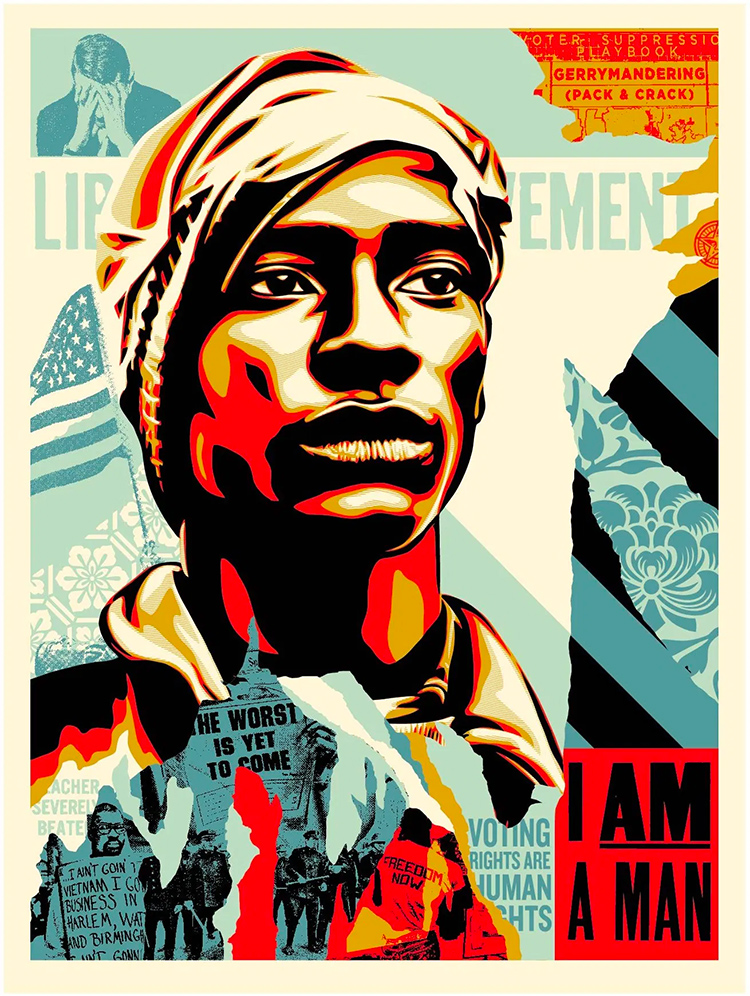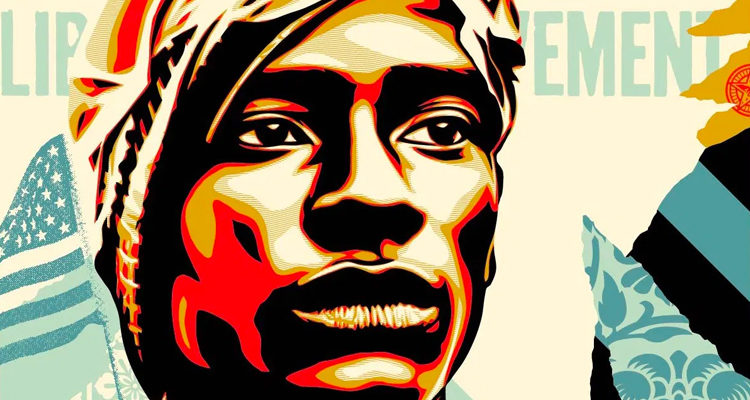UPDATE (8/3/20): Based on technical and historical considerations (and not on the mural’s content or artist), the Historic Preservation Commission has denied a Certificate of Appropriateness for the Shepard Fairey mural. Read more about it at Urban Milwaukee.
In case you missed it, artist Shepard Fairey—known for his iconic Barack Obama “Hope” poster—is set to paint a giant mural on the south side of the Railway Exchange Building, 229 E. Wisconsin Ave., in downtown Milwaukee. The mural, entitled “Voting Rights Are Human Rights,” is intended for the Democratic National Convention, but will remain a permanent fixture in Milwaukee following the conclusion of the convention.
“Voting rights and racial equality were the focus of a mass movement toward a more just society in the ’60s,” Fairey writes of the image the mural will be based upon. “Unfortunately, insidious racism, which never went away, has given way to more overt racism, and voter suppression, often targeting people of color, and students, is on the rise. Democracy needs to work for everyone.”

The city’s Historic Preservation Commission is set to discuss the approval of the mural at a 3 p.m. meeting today.
Ahead of that meeting, however, a local group of artists, musicians, and activists has expressed its displeasure with the plan.
“If the Voting Rights are Human Rights image is supposed to be supportive of voting rights,” reads a letter to the HPC, “particularly with respect to Black, Indigenous and People of Color (BIPOC), it seems incongruous that the development and consultation of this project lacks sufficient BIPOC leadership. This would not be okay under normal circumstances, but especially right now—when the Black Lives Matter movement has international momentum and is one of the largest social justice movements in our nation’s history, it feels particularly inappropriate. Given how active Milwaukee has been in support of Black Lives Matter, this project demonstrates an egregious disconnect between those planning the mural and our city’s present-day reality.”
The letter goes on to discuss Fairey’s “track record of plagiarism from street art to commercial work,” and says “we find it troubling that our city’s arts institutions and funders would consider giving resources to a problematic white male artist who purports to represent BIPOC people, but has not reached out to Milwaukee’s BIPOC artists.”
The letter includes suggested actions for the HPC, including “[working] with BIPOC artists and consultants to create a transparent, community feedback process for projects of this nature.”
Read the full letter below.
Dear Historic Preservation Commission,
We are writing this letter to request that the Historic Preservation Commission postpone the approval of the Certificate of Appropriateness for the Shepard Fairey mural installation on the Railway Exchange Building for further community dialogue.
We believe that this alteration will not only have a significant impact on the core historic value that has been placed on this building and district, but also the current and future social and emotional experiences held within the community. We believe that the voices and perspectives of the community should be central to a mural of this scope and scale. As community members who are invested in the well-being of all of our City’s artists and Black, Indigenous, and People of Color (BIPOC) communities, we hope this letter will encourage all who are involved to consider and uplift new and diverse perspectives, as well as the ways in which projects like this can be better facilitated, so that they are not harmful not only to the historic district, but to our communities, and city at large.
Historic Preservation
We support consideration of murals and public art on historically designated buildings and in Milwaukee’s significant historic districts. We feel, however, that the proposed Shepard Fairey “Voting Rights are Human Rights” mural is not compatible with the historic and architectural character of the building or district as outlined in the Historic Designation Study Report.The mural in question is proposed to go on one of the tallest, if not the tallest, buildings in the East Side Commercial Historic District. This means it will affect many other structures in terms of visuals and sightlines. This district is notable for its “visual cohesiveness,” meaning the visual aspect has been an important part of the historic designation from the start.
We also encourage members of the Historic Preservation Commission to consider these items outlined in the Commission’s Stated Purpose and Intent:
● Effect and accomplish the protection, enhancement and perpetuation of such improvements and of districts which represent or reflect elements of the city’s cultural, social, economic, political and architectural history.
● Safeguard the city’s historic and cultural heritage, as embodied and reflected in landmarks and historic districts.
● Foster civic pride in the beauty and noble accomplishments of the past.
The Voting Rights are Human Rights image that was designed as a poster in February 2020 is based on a collaboration with a New York photographer, Steve Schapiro, who documented civil rights protests in the 1960s. While it carries a worthy message, this particular image is in no way specific to Milwaukee and does not reflect our city’s “cultural, social, economic, political and architectural history”. Although the HPC ordinance does not yet directly address murals and public art, guidelines outlined generally in the ordinance should be considered in this decision.
We realize that this is a privately owned building with private funds supporting the project, but facades of buildings are on display for the public to view. We would like to see an opportunity for shared participation and transparency throughout the decision making process, when it comes to our City’s public art.
While the Historic Preservation Commision (HPC) does not have to base its decision on anything other than preserving historic buildings/districts and upholding architectural character, we urge HPC to think about culturally responsive practices and competency, cultural equity, and long term community investment as well when making facilitating a very serious decision.
Culturally Responsive Practices and Competency, Cultural Equity, and Community Investment
Cultural Competency is defined as the ability to understand, communicate with and effectively interact with people across cultures. Cultural Equity, as defined by Americans for the Arts “embodies the values, policies, and practices that ensure that all people —including but not limited to those who have been historically underrepresented based on race/ethnicity, age, disability, sexual orientation, gender, gender identity, socioeconomic status, geography, citizenship status, or religion—are represented in the development of arts policy; the support of artists; the nurturing of accessible, thriving venues for expression; and the fair distribution of programmatic, financial, and informational resources.”We believe the arts institutions involved in this project, Wallpapered City, Black Box Fund, Obey Giant and other partners, have shown a disregard for cultural competency and are promoting a project that is culturally inequitable.
If the Voting Rights are Human Rights image is supposed to be supportive of voting rights, particularly with respect to Black, Indigenous and People of Color (BIPOC), it seems incongruous that the development and consultation of this project lacks sufficient BIPOC leadership. This would not be okay under normal circumstances, but especially right now — when the Black Lives Matter movement has international momentum and is one of the largest social justice movements in our nation’s history, it feels particularly inappropriate. Given how active Milwaukee has been in support of Black Lives Matter, this project demonstrates an egregious disconnect between those planning the mural and our city’s present-day reality.
Shepard Fairey has a track record of plagiarism from street art to commercial work, as outlined here: http://www.art-for-a change.com/Obey/. We specifically find his blatant plagiarism of works by BIPOC artists including Rupert Garcia and the Young Lords Party problematic and harmful.
The Barack Obama Hope poster put Fairey on the map for many of us. This image, however, was not commissioned by, nor ever endorsed by, the Obama Campaign. Additionally, this artwork resulted in a lawsuit between the Associated Press (AP) and Fairey over copyright infringement. Fairey destroyed evidence that would likely have proven that he based the poster on an AP photograph. He was sentenced to 300 hours of community service and a $25,000 fine.
We find it troubling that our city’s arts institutions and funders would consider giving resources to a problematic white male artist who purports to represent BIPOC people, but has not reached out to Milwaukee’s BIPOC artists. We should be taking every opportunity to invest in local, and specifically BIPOC artists, especially during a pandemic that has made the already limited resources for artists even more scarce.
While we support bringing nationally and internationally recognized artists to create art with and for our city. We are against championing an artist such as Shepard Fairey, who has profited off of controversy – not to mention others’ work. With a little research, and/or by hiring consultants knowledgeable in this field, the organizations supporting the Fairey mural would find there are many other important artists, particularly BIPOC artists, who are more relevant, represent the community they are making work about, and can do so authentically.
Actions
As our society faces the realities of systemic inequities and cultural dominance, we have the opportunity to create more equitable processes to address these issues.Again, we ask that HPC consider postponing the approval of the Certificate of Appropriateness for the Shepard Fairey mural installation on the Railway Exchange Building to allow an opportunity for community dialogue.
In addition, we encourage stakeholders including Wallpapered City, Black Box Fund, and the Railway Exchange Building to instead consider the following actions:
● Acknowledge the problematic lack of cultural competency and inequity in the planned mural by Shepard Fairey on the Railway Exchange building.
● Support the creation of an inclusive public input structure and act on that public input. To date, there have not been any opportunities for this, nor has feedback been welcomed by the commission. It is unacceptable that the public was only made aware of this commission through an Urban Milwaukee article regarding the project’s Certificate of Appropriateness.
● Use public art to positively impact important issues, such as voter rights, by engaging and empowering those who are most affected by those issues. Create intentional dialogue with artists, community members and local arts institutions to create public work that is by, for and from those most affected by a topic—making sure that the narratives that affect BIPOC communities are being told from their perspectives.
● Work with BIPOC artists and consultants to create a transparent, community feedback process for projects of this nature.
Because of the prominence and scale of the location of this installation, it is crucial that we as a community make the right decision about the process and resulting image.
Thank you,
Ellie Jackson
Erick Ledesma
Katie Avila Loughmiller
Caley Conway
Vanessa Parker
Kelsey Boyle
Gabriela Riveros
Irma Román
Alhaji Camara
Emily Oliver
Johanna Rose
Fatima Laster
Jeanette Arellano
Ellie Piper
Melissa Mursch
Judith Kagen
Kari Garon
Daniel Schuyler
Lina Chambers
Rosie Petry
Juan Miguel Martinez
Valaria Tatera
Celeste Contreras
Danielle Nabak
Julio Cordova
Maddy Riordan
Dennis Carl
Beth Haskovec
Rae Johnson
Anika Kowalik
Kelly Wagner
Caressa D. Givens

